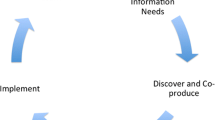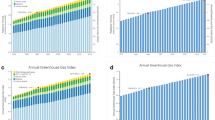Abstract
Reducing the impacts from climate change requires people to make decisions that may prompt substantial changes in their lives. One possible way to help them is with personalized decision aids. Here we describe a method for evaluating such aids, in terms of how they affect users’ understanding of their situation, defined in terms of their (a) knowledge, (b) consistency of preferences, and (c) active mastery of the material. Our method provides a simple way to evaluate the usability of climate-change decision aids, and to address concerns that the choice of display could bias users’ attitudes. We demonstrate it with the Surging Seas Risk Finder, a decision aid focused on coastal flooding (http://sealevel.climatecentral.org/).



Similar content being viewed by others
References
Bekker HL, Hewison J, Thornton JG (2004) Applying decision analysis to facilitate informed decision making about prenatal diagnosis for Down syndrome: a randomised controlled trial. Prenat Diagn 24(4):265–275
Bottrill, C (2007) Internet-based carbon tools for behaviour change. University of Oxford Environmental Change Institute, Oxford (available online at http://www.eci.ox.ac.uk/research/energy/downloads/botrill07-calculators.pdf)
Braddock CH III, Edwards KA, Hasenberg NM, Laidley TL, Levinson W (1999) Informed decision making in outpatient practice. JAMA 282(24):2313–2320
Chatterton TJ, Coulter A, Musselwhite C, Lyons G, Clegg S (2009) Understanding how transport choices are affected by the environment and health: views expressed in a study on the use of carbon calculators. Public Health 123(1):e45–e49
Crump MJ, McDonnell JV, Gureckis TM (2013) Evaluating Amazon’s Mechanical Turk as a tool for experimental behavioral research. PLoS One 8(3):e57410
de Best-Waldhober M, Daamen D, Faaij A (2009) Informed and uninformed public opinions on CO2 capture and storage technologies in the Netherlands. Int J Greenh Gas Control 3(3):322–332
Dietz T, Gardner GT, Gilligan J, Stern PC, Vandenbergh MP (2009) Household actions can provide a behavioral wedge to rapidly reduce US carbon emissions. PNAS 106(44):18452–18456
Fischhoff B (2013) The sciences of science communication. PNAS 110(Supplement 3):14033–14039
Fischhoff, B, Davis, AL (2014) Communicating scientific uncertainty. PNAS
Fischhoff B, Brewer N, Downs JS (eds) (2011) Communicating risks and benefits: an evidence-based users’ guide. Food and Drug Administration, Washington
Füssel HM (2007) Adaptation planning for climate change: concepts, assessment approaches, and key lessons. Sustain Sci 2(2):265–275
Kahneman D (2011) Thinking, fast and slow. Farrar Giroux & Strauss, New York
Lichtenstein SL, Slovic P (eds) (2006) The construction of preferences. Cambridge University Press, New York
Lusardi, A (2008) Financial Literacy: An Essential Tool for Informed Consumer Choice? (No. w14084). National Bureau of Economic Research
Maglio SJ, Trope Y, Liberman N (2013) The common currency of psychological distance. Psychol Sci 22(4):278–282
Mason W, Suri S (2012) Conducting behavioral research on Amazon’s Mechanical Turk. Behav Res Methods 44(1):1–23
Matthies M, Giupponi C, Ostendorf B (2007) Environmental decision support systems: Current issues, methods and tools. Environ Model Softw 22(2):123–127
Meinke H, Stone RC (2005) Seasonal and inter-annual climate forecasting: the new tool for increasing preparedness to climate variability and change in agricultural planning and operations. Clim Chang 70(1–2):221–253
Nicholson-Cole SA (2005) Representing climate change futures: a critique on the use of images for visual communication. Comput Environ Urban Syst 29(3):255–273
Noar SM, Benac CN, Harris MS (2007) Does tailoring matter? Meta-analytic review of tailored print health behavior change interventions. Psychol Bull 133(4):673–693
O’Connor AM, Tugwell P, Wells GA, Elmslie T, Jolly E, Hollingworth G, McPherson R, Bunn H, Graham I, Drake E (1998) A decision aid for women considering hormone therapy after menopause: decision support framework and evaluation. Patient Educ Couns 33(3):267–279
Olson GM, Olson JS (2003) Human-computer interaction: psychological aspects of the human use of computing. Ann Rev Psychol 54(1):491–516
Padgett JP, Steinemann AC, Clarke JH, Vandenbergh MPA (2008) Comparison of carbon calculators. Environ Impact Assess Rev 28(2):106–115
Salvendy G (2012) Handbook of human factors and ergonomics. Wiley, Indiana
Simao A, Densham PJ, Haklay M (2009) Web-based GIS for collaborative planning and public participation: an application to the strategic planning of wind farm sites. J Environ Manag 90(6):2027–2040
Spence A, Poortinga W, Pidgeon N (2012) The psychological distance of climate change. Risk Anal 32(6):957–972
Strauss BH, Ziemlinski R, Weiss JL, Overpeck JT (2012) Tidally adjusted estimates of topographic vulnerability to sea level rise and flooding for the contiguous United States. Environ Res Lett 7(1):014033
Szwajcer EM, Hiddink GJ, Koelen MA, van Woerkum CM (2009) Written nutrition communication in midwifery practice: what purpose does it serve? Midwifery 25(5):509–517
Tebaldi C, Strauss BH, Zervas CE (2012) Modelling sea level rise impacts on storm surges along US coasts. Environ Res Lett 7(1):014032
Ver Steegh N (2002) Yes, no, and maybe: Informed decision making about divorce mediation in the presence of domestic violence. Wm Mary J Women L 9:145
Volk RJ, Spann SJ, Cass AR, Hawley ST (2003) Patient education for informed decision making about prostate cancer screening: a randomized controlled trial with 1-year follow-up. Ann Fam Med 1(1):22–28
von Winterfeldt D (2013) Bridging the gap between science and decision making. PNAS 110(Supplement 3):14055–14061
Wong-Parodi, G, Strauss, B (2014) Team science for science communication, PNAS (in press)
Acknowledgments
This work was supported by a research grant from the Rockefeller Foundation and the Center for Climate and Energy Decision Making (SES-0949710). The authors thank Jack Wang and Dan Rizza for their support with the experiment.
Author attributions
All authors contributed to the conception and the design of the tests and the experiment used within the work presented. G.W.P. ran the experiment and analyzed the data. G.W.P. and B.F. led in the writing of the paper, with input from B.S.
Competing financial interests
The authors declare no competing financial interests.
Author information
Authors and Affiliations
Corresponding author
Rights and permissions
About this article
Cite this article
Wong-Parodi, G., Fischhoff, B. & Strauss, B. A method to evaluate the usability of interactive climate change impact decision aids. Climatic Change 126, 485–493 (2014). https://doi.org/10.1007/s10584-014-1226-9
Received:
Accepted:
Published:
Issue Date:
DOI: https://doi.org/10.1007/s10584-014-1226-9




